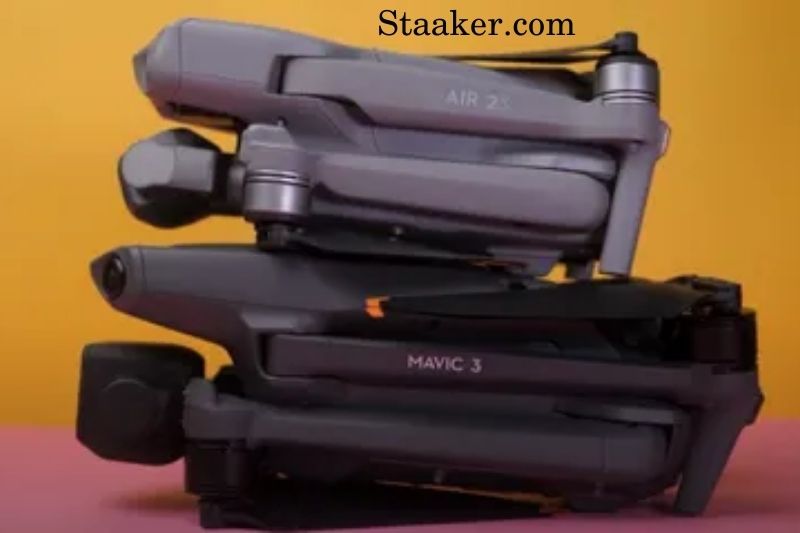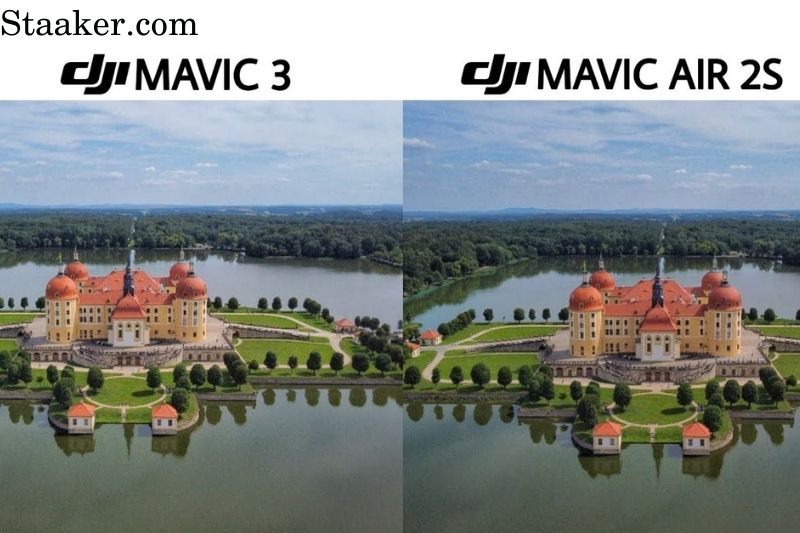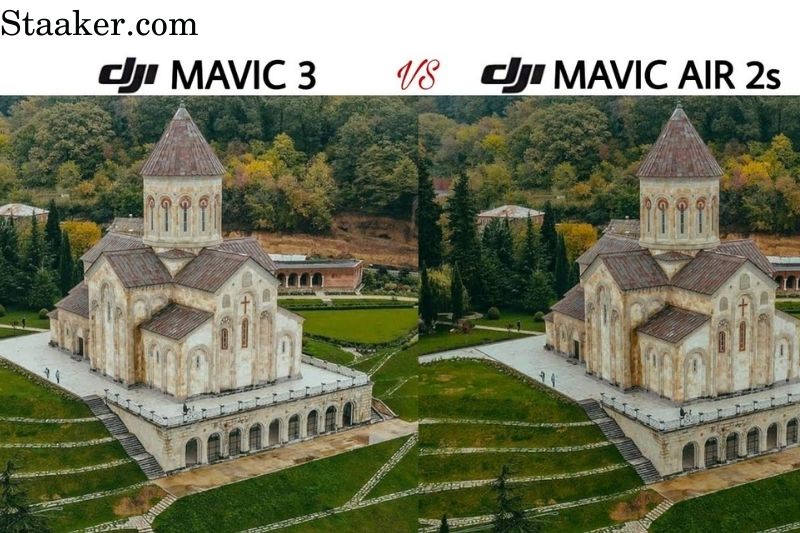When it comes to drones, there are a lot of different options to choose from. But if you’re looking for the best of the best, you need to check out the Dji Mavic 3 vs Air 2S.
These two drones are some of the most popular on the market, and for a good reason. They both offer amazing features and performance. But which one is the better option for you?
Design
The two planes share many similarities in terms of design, especially when looking at photographs without scale. Both have legs that fold together to form a roughly rectangular fuselage that houses the battery. The Mavic 3 slides in and out of the back, but the battery on the Air 2S takes up a large portion of the back.
In either case, the airframe features multiple vision sensors at the front, top, base, and sides in the case of the Mavic 3. This allows for practical obstacle avoidance.
Because the landing legs are built into the airframe, and the camera gimbal is close to the front, take-off and landing should be done on a landing mat (see our guide to the best drone landing mats) to keep grass and dust out of the propellers, motors, and lens.
Instead of attaching an upside-down cup of possibly brittle plastic around the gimbal while your drone is not in use, the Mavic 3 includes a complete body protective shell with a far more convincing clip that encases the fuselage and provides some protection for the attached propellors.
Maneuvrability & Speed
In terms of true speed, the Mavic 3 has a slight advantage over the Air 2S, with an ascending rate of 8 meters per second (m/s) versus 6m/s. Both have a maximum speed of 19 m/s (42 mph) and a decent speed of 6 m/s. Thus while the Air 2S is more consistent vertically, the faster ascent is a technical triumph.
Unless you frequently need to show the ground beneath you, this is effectively a tie. The more remarkable maximum ascent, given the heavier weight, implies a higher reliable maximum power output from the motors.
The Mavic 3 and the Air 2S provide a reasonably similar flying experience for the pilot, especially if you choose the regular Mavic 3, as both drones come with identical controllers. The only subjective difference is that it feels more challenging to attain gradual yaw on the Mavic 3, but this problem can be rectified by modifying the control curves.
Many users who came from older DJI drones that used the ‘Go 4’ software struggled to find this modification and blamed the machine, but it is there. We’d be more concerned that it’s accessible to yaw and pitch pretty severely while attempting to land – the trick is to avoid doing so too close to a tree.
Battery Life
- Mavic 3: 40-46 mins
- Air 2S 2: 30-31 mins
There is some debate about whether the Air 2S’s 3,500 or 3,750 mAh 3-cell battery provides the same flight duration or power as the Mavic 3’s 5,000 mAh 4-cell battery. That difference is only a few volts, but it gives additional potential propulsion for faster acceleration and, more importantly for most operators, a hovering time approaching three-quarters of an hour.
It’s worth remembering that 30 minutes is still a long time to be in charge of an aircraft, and many pilots would like to land slightly more regularly to replace batteries and relax for a few seconds before returning to work. Unless you’re filming a lot of ‘Hyperlapse’ (timelapse) effects or other things where a few extra minutes in the air could make a big difference, battery life isn’t as crucial after half an hour.
A multi-charger is an option with the Fly More kit in both circumstances, and it’s well worth acquiring if you can.
Gimbal & Camera
As we mentioned under design, the camera is mounted on a gimbal, which is then fixed to the aircraft’s body. The Air 2S features a single camera with a 1-inch sensor in its camera housing. In contrast, the Mavic 3 manages to cram a 4/3-inch primary camera plus a half-inch zoom camera onto an admittedly asymmetrical chassis.
The second camera is both fantastic and a little disappointing; when zoomed in, the video it captures isn’t up to par (it doesn’t even use the Cine’s uncompressed formats), but it may be a valuable tool for recognizing subjects, and its applications for a surveyor or in restricted areas are evident.
The main camera is far more remarkable, with a sensor the same size as a Micro Four Thirds camera (but without the interchangeable lenses). The only compromise appears to be room for the entire gimbal to rotate.
The Air 2S inherits the ability to pan the camera from left to right simply by tapping and dragging on the screen from its predecessor. However, the Mavic 3 camera housing can only pan 5 (and only 27 mechanically).
It may seem strange to restrict this feature on the next model up, but since turning only directed the lens at the drone’s legs and motors, learning to yaw the entire aircraft to get a better photo may be preferable!
Finally, because the aircraft have rectangular (or irregular polygonal) fronts, the manufacturer’s clip-to-fit filters (included in their bundles) will make attaching filters much more accessible.
Controller & Range
The Mavic 3 (regular) and Air 2S come with essentially the same controller; it’s a solid design with few flaws. It tucks nicely into your bag once you’ve unscrewed the control sticks, set them in the carefully designed grips, tucked in your phone link and pressed down the antenna and grip.
We like how your phone link cord (i.e., iPhone or USB) tucks neatly into a storage bin beneath the antenna, eliminating the need to find and connect it with each flight, as with other DJI drones.
The Mavic 3 has a slight advantage in range, at least in the FCC region where the higher radio power is permissible, but the quality is excellent. The actual benefit of the Mavic 3 is the 60fps live view, which makes the FPV footage seem stunning (at least at shorter ranges), not that the Air 2S is poor. Dropouts are infrequent because both crafts have four antennae.
The RC Pro controller with a built-in screen and more professional control sticks is included in the Mavic 3 Cine package, removing the need to connect your phone. On the other hand, the conventional remote is less of an issue than previous models: it can keep your phone battery charged and still work for 4 hours (rather than the whole 6), which is more than enough for most people.
Active Track and Obstacle Avoidance Sensors
Because of a combination of updated software and a variety of six fish-eye vision sensors and two wide-angle sensors to create a 360 obstacle avoidance system, the new APAS 5.0 Obstacle Avoidance System is slightly better than the one in the Air 2s.
Return to home technology employs this avoidance technique in a novel way. Instead of flying in a straight line, the Mavic 3 allows the drone to follow a calculated route home for the first time.
The new Active Track 5.0 improves on previous versions by allowing the drone to track the subject while moving forward, backward, left, right, diagonally, and flying alongside it. Even if the topic loses focus for a second, increasingly sophisticated algorithms and powerful cameras can estimate where it will be.
Dynamic Range
The Mavic 3’s color profile is flatter, but that doesn’t necessarily mean the dynamic range is more significant. According to my experiments, both drones have a pretty similar dynamic range, which is also validated by actual specs.
The Mavic 3 offers 12.8 stops of dynamic range compared to 12.6 stops for the Air 2s. However, the change is so minor that it is practically meaningless.
Still Photos
Both drones have a similar level of detail for still photographers (though not identical image sizes). Still, the Mavic 3 has manual control over the aperture and the mixed benefits of the zoom camera. There is no way to deny the advantage gained from the significantly larger 4/3 inch sensor on what DJI calls the Hasselblad camera. Given that they own the brand, the zoom camera falls short of this designation tells a lot.
So, which camera is better? It’s tough not to give this to the Mavic 3, which has around one stop more dynamic range than the Air 2S, but is it worth more than twice the price?
We’re not convinced. The zoom lens stops being fun for those without a professional application because the image quality won’t earn you big bucks as a flying paparazzo, which limits its application to – as we’ve mentioned – surveyors or perhaps those who need to stay outside safety zones, even if it means sacrificing quality.
As the image from the Air 2S above indicates, the option to alter the aperture for depth of field reasons plays even less of a role in the air than you might think. The /2.8 lens (with autofocus) will serve most users well for available aerial photos and closer images, putting a changeable aperture in the ‘nice to have’ column rather than a requirement as it would be on a DSLR.
Video
Let’s start with the most expensive elephant in the room: the Mavic 3’s two flavors mean that the standard version can capture standard.mp4 and.mp5 video (at up to 200bps). In contrast, the Mavic 3 Cine – for more than twice the price – can also capture Apple ProRes 422 HQ video onto a built-in 1TB of SSD storage.
This is similar to the video’s version of Raw, with a high tolerance for tonal adjustments in editing but with the added benefit of being editable right out of the drone. Yes, it’s a large file, but there won’t be time for a rendering cup of tea (or whatever creative stimulant you like; we won’t judge).
The basic Mavic 3 generates somewhat better video quality in theory, with a bitrate of up to 200 Mbps compared to the Air 2S’s 150 Mbps, yet analyzing identical 4K photos, you’d be hard-pressed to notice any difference in the way the compression handles even the finicky elements like the trees. The Air 2S has a somewhat contrasting appearance, especially when shooting D-Log.
The Mavic 3’s tele camera can only shoot 4K at 30 frames per second (or 1080p) because of its 12MP sensor, but the 162mm equivalent focal length gives you a unique perspective. It’s still unclear why at least 24 frames per second, and ideally 50 or 60 frames per second, aren’t on the cards.
Software Features
Both drones use the DJI Fly app, which some thought was exclusive for consumers until the Mavic 3 arrived, but now appears to be replacing every instance of the ‘Go 4’ software. Aside from the additional camera and lens, both aircraft offer a similar set of functions, albeit the Mavic 3’s pilot aid software (APAS) has been updated from version 4 to 5.
This results in a slightly more dependable experience with ActiveTrack, which can latch onto a person or vehicle and follow them as they move (after a significant delay with the software update).
The drones will recognize their path of travel and utilize object avoidance to stay with them even if something gets in the way – it even made it through the trees in the photo (though, to be honest, that seemed like luck rather than robotic judgment).
APAS 5 on the Mavic 3 seems to have a lot of trouble separating people and vehicles from, say, a grassy field, at least in our early testing, which wasn’t entirely encouraging and implies things haven’t progressed as much we’d hoped from the Air 2S.
However, we doubt you’ll deliberately dare your drone to see how close it can get to a tree (sorry, DJI), so these features can be handy substitutes for a second pilot. However, don’t think the Mavic 3 is as far ahead as some promotional videos claim!
Verdict
The critical choice here is between a fair investment that provides you with 90% of the capabilities you’ll ever need and the top of the folding line with its few extra enticements, especially if the SSD isn’t appealing to you.
The smaller and more portable Air 2S is a benefit, but it’s partly countered that both it and the Mavic 3 weigh more than the 249g limit on which so much is based; in some regions, they may both weigh 19kg (40lb).
On the surface, the Mavic 3’s camera appears to provide a lot more flexibility, but we’re willing to bet you’ll only use the primary camera, in which case the larger sensor keeps you ahead, but not by much. The camera on the Air 2S is better than many thought possible in such a small drone not long ago, and it’s the same size as the Mavic 2 Pro, which many aspired to.
The Mavic 3 is significantly faster than the Air 2S at avoiding obstacles if that feature is activated (many pros keep it off) and mapping paths around challenges.
The Mavic 3 would undoubtedly benefit a professional, especially when handling video. Still, the Air 2S has a large enough sensor to take amazing photographs and video in low light, can capture more excellent quality than 4K, and, to be honest, appears to compete visually. At the same time, if you’re less secure in the air, the collision avoidance will do its job (if not as quickly), so the Mavic 3 is an exciting option that requires you to check a few boxes to justify the additional cost.
DJI Air 2s
- Most folks seeking a decent camera drone will find this the best option.
- For the benefit of YouTubers (as youtube compresses the videos a lot anyway)
- For everyday users
- For wedding photographers and videographers who don’t require the best low-light image possible.
Mavic3
- It’s ideal for cinematographers.
- Great for more severe advertisements.
- Videos of music
- Rescue and Search
- Commercials on television
FAQs
Is the Mavic 3 a water-resistant drone?
The Mavic 3, like every other DJI drone, is not waterproof, and flying it in the rain is not recommended. DJI also advises against flying in high humidity or foggy conditions since precipitation could cause a short circuit, rendering the drone inoperable and leading it to crash.
What is the maximum weight that a Mavic 3 can carry?
DJI FORUM | DJI Mavic 3-Max Take Off Weight What is the Mavic 3’s maximum take-off weight? We know that the weight is between 895 and 899 grams.
Is it possible to fly the DJI Air 2s in the snow?
We do not advocate flying the unit in the snow or the rain since it may cause problems. The suggested temperature for the DJI Mavic Air 2 is shown in the figure below. Thank you very much for your patience and support.
Video
Related Post:
Conclusion
There are many differences between the Dji Mavic 3 and the Air 2S. The Mavic 3 is the newest and most advanced drone from DJI, while the Air 2S is a more affordable option.
The Mavic 3 has a longer flight time, a higher top speed, and a more powerful camera. The Air 2S is smaller and lighter, making it more portable. Thank you for reading Staaker’s article!











